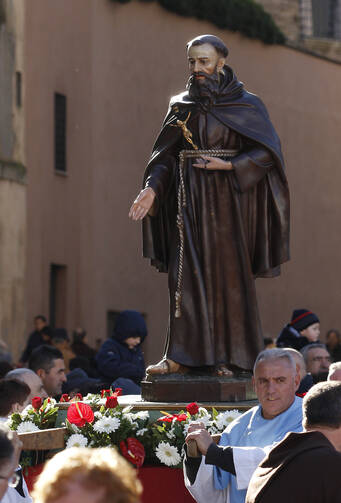One of my favorite passages from my collection of spiritual books is a section on vocation from Thomas Merton's No Man is an Island. Speaking of St. Francis of Assisi, Merton writes:
The remarkable thing about St. Francis is that in his sacrifice of everything he had also sacrificed all the "vocations" in a limited sense of the word. After having been edified for centuries by all the various branches of the Franciscan religious family, we are surprised to think that St. Francis started out on the roads of Umbria without the slightest idea that he had a "Franciscan vocation." And in fact he did not. He had thrown all vocations to the winds together with his clothes and other possessions. He did not think of himself as an apostle, but as a tramp. He certainly did not look upon himself as a monk: if he had wanted to be a monk, he would have found plenty of monasteries to enter. He evidently did not go around conscious of the fact that he was a "contemplative." Nor was he worried by comparisons between the active and contemplative lives. Yet he led both at the same time, and with the highest perfection. No good work was alien to him--no work of mercy, whether corporal or spiritual, that did not have a place in his beautiful life! His freedom embraced everything.
I think about this passage within the context of education, and specifically in the context of the language we use when we invite our students and children to think about the future. We encourage them to think of their grown-up lives in categories fit for a capitalist economy, that is, in light of particular professions and fields. "What do you want to be when you grow up?" "What do you want to major in?" By the time students reach high school, they hear the call to pragmatism; they feel the pressures to find a job that will pay bills and set them on the road to retirement. Those, to be clear, are important goals; I'm not suggesting we risk permanent dependency. But in our desire to lead students to safety and happiness, we can too quickly condense the richness of human life and the possibilities of a mature adulthood. Instead of expanding imaginations, we can limit them, introducing students only to standard career choices: doctor, lawyer, engineer, banker . . . or something else that earns Society's approval.
And yet, how much room does this leave for grace? How much room does it leave for the infinite creativity of the Creator?
Merton notes that St. Francis could have articulated his spiritual journey in the lingua franca of his time and place. But he did not; he didn't choose a particular profession or a previously articulated vocational category. He chose first an attitude: a total openness to God. This began, as Merton notes, with a stripping away, with a removal of anything that would diminish his fidelity.
Catholic educators, facing students stressed about their futures, must continuously invite students to do something like St. Francis did: see the vocations of the world in light of the first and most important vocation: responding generously and courageously to a loving God. It's not that students should refuse to become doctors or lawyers or engineers; the question is rather on what grounds, and for what reasons, they will become doctors, lawyers or engineers. The question is whether those decisions result from true spiritual freedom. In other words: Have they chosen those professions (or any profession, for that matter) because that is where they believe God has led them? Or have they chosen a profession because of the concern for money, prestige, security, or relevance?
This is difficult work. Students, like everyone of us no matter our age, want to have a plan. Security delivers emotional comfort. Security is a primal driving force. But this is where Catholic education has to offer something radically different, and maybe even a bit unsettling. The path to spiritual freedom often involves uncertainty and sacrifice. When Jesus calls Peter and Andrew, the Gospel of Matthew tells us, "At once they left their nets and followed him." Here, Peter and Andrew anticipate St. Francis: For where were they going? With whom were they going? They didn't know. In dropping their nets, they were dropping the symbol of their livelihood, the totem of their identity. In dropping their nets, they were dropping a version of themselves conceived on the terms of the world. Christ's tap on the shoulder awakened them to their supernatural self.
This is our task. A Catholic educator must continuously call students to their supernatural vocation. We must teach calculus and English; we must teach biology and physics, earth science and French. But beyond this, we must teach them how to drop their nets, so that what is said of St. Francis can be said of our students: Their freedom embraced everything.








